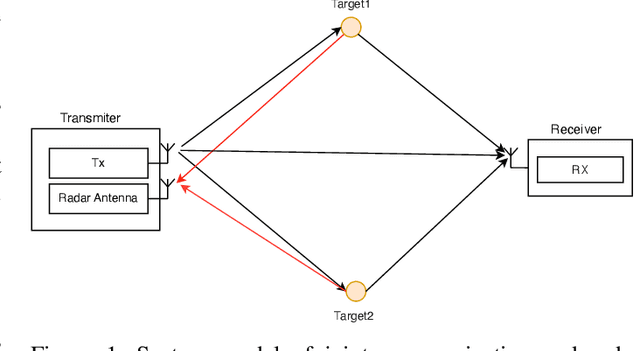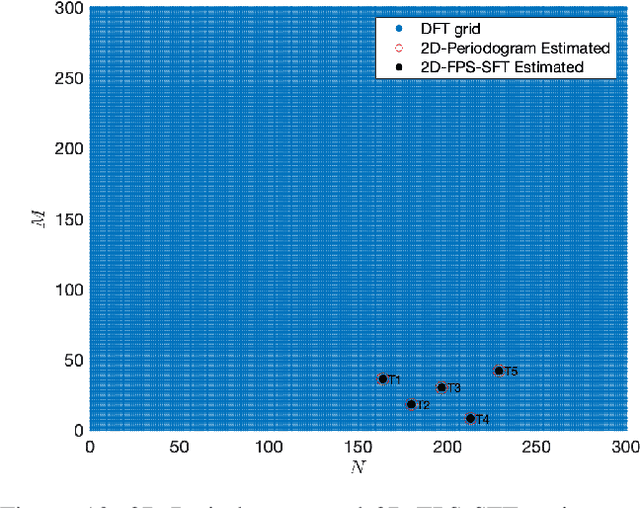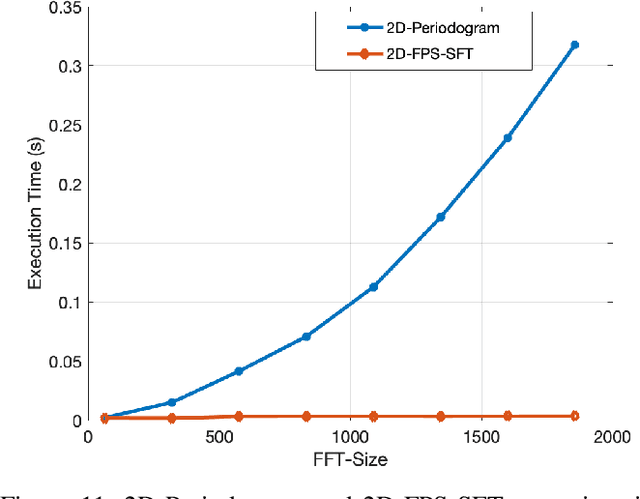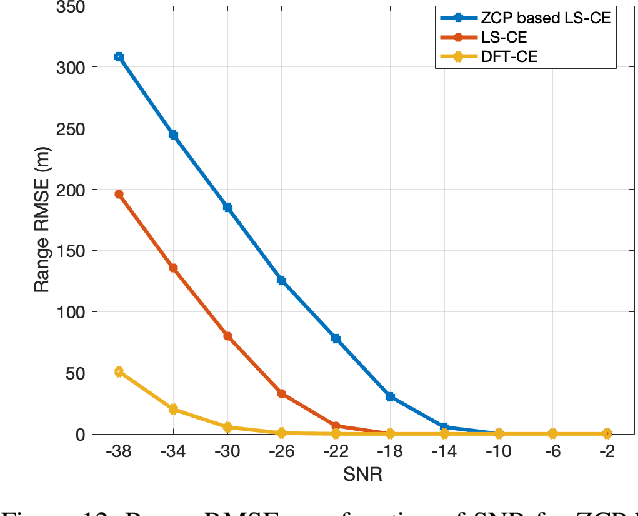Guevara Noubir
An Efficient Radar Receiver for OFDM-based Joint Radar and Communication Systems
Sep 08, 2022



Abstract:We propose in this work a radar detection system for orthogonal-frequency division multiplexing (OFDM) transmission. We assume that the transmitting antenna Tx is colocated with a monostatic radar. The latter knows the transmitted signal and listens to echoes coming from the reflection of fixed or moving targets. We estimate the targets parameters (range and velocity) using a 2D-Periodogram. Moreover, we improve the estimation performance in low signal to noise ratio (SNR) conditions using the discrete Fourier transform channel estimation (DFT-CE) and we show that Zadoff-Chu precoding (ZCP) adopted for communication, does not degrade the radar estimation in good SNR conditions. Furthermore, since the dimensions of the data matrix can be much larger than the number of targets to be detected, we propose a sparse Fourier transform based Fourier projection-slice (FPS-SFT) algorithm to reduce the computational complexity of the 2D-Periodogram. An appropriate system parameterization in the 77GHz industrial, scientific and medical (ISM) band, allows to achieve a range resolution of 30.52 cm and a velocity resolution of 0.67 m/s and to reduce the periodogram computation time up to around 98.84%.
DEFORM: A Practical, Universal Deep Beamforming System
Mar 18, 2022



Abstract:We introduce, design, and evaluate a set of universal receiver beamforming techniques. Our approach and system DEFORM, a Deep Learning (DL) based RX beamforming achieves significant gain for multi antenna RF receivers while being agnostic to the transmitted signal features (e.g., modulation or bandwidth). It is well known that combining coherent RF signals from multiple antennas results in a beamforming gain proportional to the number of receiving elements. However in practice, this approach heavily relies on explicit channel estimation techniques, which are link specific and require significant communication overhead to be transmitted to the receiver. DEFORM addresses this challenge by leveraging Convolutional Neural Network to estimate the channel characteristics in particular the relative phase to antenna elements. It is specifically designed to address the unique features of wireless signals complex samples, such as the ambiguous $2\pi$ phase discontinuity and the high sensitivity of the link Bit Error Rate. The channel prediction is subsequently used in the Maximum Ratio Combining algorithm to achieve an optimal combination of the received signals. While being trained on a fixed, basic RF settings, we show that DEFORM DL model is universal, achieving up to 3 dB of SNR gain for a two antenna receiver in extensive experiments demonstrating various settings of modulations, bandwidths, and channels. The universality of DEFORM is demonstrated through joint beamforming relaying of LoRa (Chirp Spread Spectrum modulation) and ZigBee signals, achieving significant improvements to Packet Loss/Delivery Rates relatively to conventional Amplify and Forward (LoRa PLR reduced by 23 times and ZigBee PDR increased by 8 times).
Towards an AI-Driven Universal Anti-Jamming Solution with Convolutional Interference Cancellation Network
Mar 18, 2022



Abstract:Wireless links are increasingly used to deliver critical services, while intentional interference (jamming) remains a very serious threat to such services. In this paper, we are concerned with the design and evaluation of a universal anti-jamming building block, that is agnostic to the specifics of the communication link and can therefore be combined with existing technologies. We believe that such a block should not require explicit probes, sounding, training sequences, channel estimation, or even the cooperation of the transmitter. To meet these requirements, we propose an approach that relies on advances in Machine Learning, and the promises of neural accelerators and software defined radios. We identify and address multiple challenges, resulting in a convolutional neural network architecture and models for a multi-antenna system to infer the existence of interference, the number of interfering emissions and their respective phases. This information is continuously fed into an algorithm that cancels the interfering signal. We develop a two-antenna prototype system and evaluate our jamming cancellation approach in various environment settings and modulation schemes using Software Defined Radio platforms. We demonstrate that the receiving node equipped with our approach can detect a jammer with over 99% of accuracy and achieve a Bit Error Rate (BER) as low as $10^{-6}$ even when the jammer power is nearly two orders of magnitude (18 dB) higher than the legitimate signal, and without requiring modifications to the link modulation. In non-adversarial settings, our approach can have other advantages such as detecting and mitigating collisions.
Spectro-Temporal RF Identification using Deep Learning
Jul 11, 2021



Abstract:RF emissions detection, classification, and spectro-temporal localization are crucial not only for tasks relating to understanding, managing, and protecting the RF spectrum, but also for safety and security applications such as detecting intruding drones or jammers. Achieving this goal for wideband spectrum and in real-time performance is a challenging problem. We present WRIST, a Wideband, Real-time RF Identification system with Spectro-Temporal detection, framework and system. Our resulting deep learning model is capable to detect, classify, and precisely locate RF emissions in time and frequency using RF samples of 100 MHz spectrum in real-time (over 6Gbps incoming I&Q streams). Such capabilities are made feasible by leveraging a deep-learning based one-stage object detection framework, and transfer learning to a multi-channel image-based RF signals representation. We also introduce an iterative training approach which leverages synthesized and augmented RF data to efficiently build large labelled datasets of RF emissions (SPREAD). WRIST detector achieves 90 mean Average Precision even in extremely congested environment in the wild. WRIST model classifies five technologies (Bluetooth, Lightbridge, Wi-Fi, XPD, and ZigBee) and is easily extendable to others. We are making our curated and annotated dataset available to the whole community. It consists of nearly 1 million fully labelled RF emissions collected from various off-the-shelf wireless radios in a range of environments and spanning the five classes of emissions.
 Add to Chrome
Add to Chrome Add to Firefox
Add to Firefox Add to Edge
Add to Edge